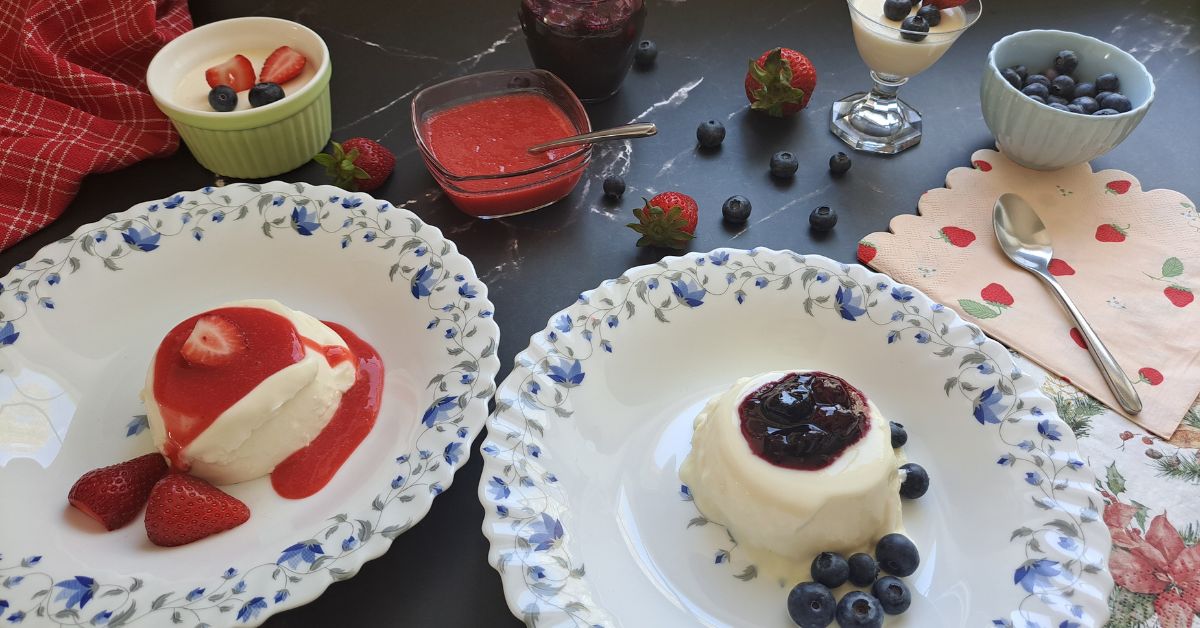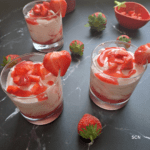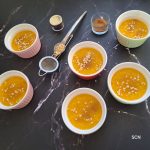Panna cotta

Panna cotta is a classic Italian dessert known for its creamy texture and delicate flavour. The name “panna cotta” translates to “cooked cream” in Italian, accurately describing its preparation method. It is a creamy custard-like dessert made by simmering together cream, milk, sugar, and gelatin until the mixture is thickened and set. The result is a smooth, velvety pudding-like consistency that melts in your mouth with every spoonful.
The basic ingredients for panna cotta are heavy cream, milk, sugar, vanilla extract, and gelatin. Panna cotta is simple to prepare, but perfect texture requires careful attention to the gelatin-to-liquid ratio and setting process. It is served chilled and often paired with fresh berries to balance its richness.
What sets panna cotta apart is its versatility. The traditional recipe calls for a simple blend of cream, sugar, and gelatin, but you can easily customize this dessert with various flavourings and toppings to suit individual tastes and preferences. The possibilities are endless, from classic vanilla-infused panna cotta to chocolate or fruity variations.
One of the most appealing aspects of panna cotta is its ease of preparation. With just a handful of ingredients and minimal cooking time, you can create a dessert, perfect for casual dinners and special occasions. Serve them in individual moulds, ramekins, or elegant glassware. Garnish with fresh berries, fruit compote, caramel sauce, or a drizzle of honey.
Tips and tricks for making this simple yet delicious dessert.
Use Quality Ingredients:
Use high-quality ingredients, such as fresh cream, milk, and vanilla extract, can make a significant difference in the flavour and texture of the final product.
Bloom Gelatin Properly:
Blooming gelatin is the process of hydrating it in liquid before adding it to the recipe. Make sure to sprinkle the gelatin evenly over cold water and let it sit undisturbed for a few minutes until it becomes soft and spongy. This ensures the gelatin dissolves evenly when added to the warm milk mixture.
Avoid Boiling:
When heating the milk and cream mixture, avoid boiling it. Boiling can cause the proteins in the dairy to curdle and result in a grainy texture. Instead, heat the mixture gently until it steams and shows small bubbles around the edges.
Strain the Mixture:
After heating the milk mixture and dissolving the gelatin, strain it through a fine-mesh sieve to remove any lumps or undissolved gelatin. This step helps ensure a smooth and silky texture for the panna cotta.
Use Moulds or Glasses:
You can set this dessert in various moulds or glasses, depending on your preference. If using moulds, lightly grease them with a neutral oil or cooking spray before pouring them into the mixture to help with later unmolding.
Allow Sufficient Chilling Time:
To achieve the perfect texture, refrigerate panna cotta for several hours, preferably overnight. Be patient and resist the urge to unmold or serve the dessert before it fully sets.
Unmold with Care:
If unmolding the panna cotta, dip the bottom of the moulds briefly in warm water to loosen the edges. Then, gently invert the moulds onto serving plates and give them a slight shake or tap to release the panna cotta.
Serve with Garnishes:
Panna cotta is delicious on its own, but you can enhance its flavour and presentation by serving it with fresh berries, fruit compote, caramel sauce, or a sprinkle of grated chocolate. Get creative with your toppings!
Gelatin
You can use both gelatin powder and gelatin sheets to make panna cotta.
Gelatin Powder:
Home kitchens commonly use this form of gelatin. It usually comes in powdered form, making it easy to measure and use. To use gelatin powder in panna cotta, you typically sprinkle it over cold water to bloom (soften and swell) it before adding it to the warm cream mixture. Once bloomed, you heat the mixture gently to dissolve the gelatin completely.
Gelatin Sheets:
Also known as leaf gelatin or gelatin sheets are thin, translucent sheets made from dried gelatin. They come in different strengths, which are usually indicated by a numerical rating. To use gelatin sheets in panna cotta, you soak them in cold water until they become soft and pliable (usually for about 5 to 10 minutes). Then, you wring out the excess water and add the softened sheets to the warm cream mixture, stirring until completely dissolved.
Gelatin sheets typically come in various strengths, often indicated by a numerical rating. As a general guideline, for a standard firmness panna cotta using gelatin sheets with moderate strength (around 160-200 bloom), you might use about 3 to 4 sheets for every 400 ml of liquid mixture. However, it’s essential to refer to the instructions on the packaging of your gelatin sheets, as the recommended usage can vary between brands and types of gelatin.
Both forms of gelatin can achieve the desired consistency for panna cotta when used correctly. The choice between gelatin powder and gelatin sheets often comes down to personal preference and availability.
Quick tip
It’s best to use cold water to bloom or hydrate the gelatin. Hot water can denature the gelatin proteins and prevent them from properly setting or gelling.
Remember not to let the mixture boil, as boiling can alter the texture and taste of the panna cotta.



Panna cotta
Ingredients
- 200 ml milk preferably 3% fat content
- 200 ml heavy cream
- 3 tbsp sugar
- 1 tsp vanilla extract
- 1 tsp gelatin powder
- 1 tbsp cold water
- Pinch of salt optional
Instructions
- In a small bowl, sprinkle the gelatin powder over the cold water. Let it sit for about 5-10 minutes to soften and bloom.
- In a saucepan combine the milk, salt (if using) and sugar. Heat the mixture over medium heat, stirring occasionally, until it begins to simmer. Do not boil.
- The ideal temperature is 60°C. At this temperature, the mixture will start to steam and show small bubbles around the edges, indicating that it’s hot but not yet boiling.
- Remove the saucepan from the heat and stir in softened gelatin to the warm milk mixture, stirring until the gelatin is completely dissolved.
- After adding gelatin to your mixture, stir gently and avoid vigorous mixing to prevent the formation of air bubbles.
- Add the heavy cream and vanilla extract.
- Strain the mixture through a fine-mesh sieve to remove any lumps or undissolved gelatin. This step is purely optional.
- Divide the mixture evenly among serving glasses or ramekins.
- Allow the panna cotta to cool to room temperature, then cover each glass or ramekin with plastic wrap and refrigerate for at least 4 hours, or until set.
- Once set, garnish the panna cotta with fresh berries, fruit compote, or a drizzle of caramel sauce, if desired.
- Serve chilled and enjoy the silky smooth texture and creamy flavour of this delightful Italian dessert.
- Panna cotta is incredibly versatile and can be customized with various flavourings such as coffee, citrus, chocolate, or even spices like cinnamon or cardamom.
Notes
- Greasing the moulds with cooking spray or a neutral oil before pouring in the panna cotta mixture helps prevent it from sticking to the mould and facilitates easy removal once the dessert has set. This step is crucial, especially if you plan to unmold the panna cotta and serve it individually on plates. It ensures the dessert maintains its shape and appearance when transferred from the mould to the serving dish. Additionally, neutral oil or cooking spray helps avoid imparting unwanted flavours to the panna cotta.
- You can also boil the milk and cream together. Once the mixture is hot (not boiling), it can be combined with gelatin and then chilled until set.
- Strain the milk and cream mixture to ensure a smooth and creamy texture in the final dessert.
- Whisking or stirring too vigorously after adding gelatin to your mixture can introduce air bubbles, which leads to a foamy or bubbly surface on your final result.
Share Your Creations and Connect with Me on Social Media!
Have you tried this recipe? Don’t forget to tag me with your pictures on Instagram – I love to see your creations! 💕 Also, be sure to comment and rate below! Follow me on social media:
1 thought on “Panna cotta”